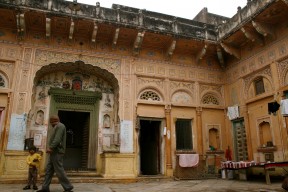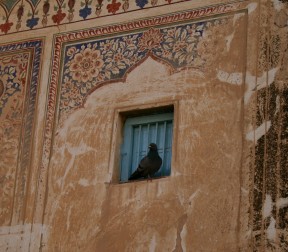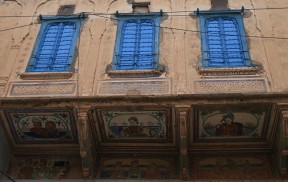Take a small detour from the famous Spice Route of old into a relatively undiscovered part of rural Rajasthan and one of the world’s only open-air art galleries. Painted houses fade like painted ladies of old. Their stately presence, battered shutters and pigeon filled lofts disguise an ancient beauty now fading into red tinged sunsets.
It their heyday, the famous painted houses of the Shekhawati region were the belles of the ball of the Marwari traders. Today the outdoor art gallery of Shekhawati is a hidden jewel in the tourist circuit of Rajasthan. Small towns dotting the surrounding farmland give up unique and delightful tapestries of life painted onto the walls and eaves of crumbling havelis. It is a history both new and old; frescos painted on walls detail a period of one hundred years, a time of great change and movement.
With the arrival of the British and the East India Trading Company, many traders of this area moved to the port of Kolkata where they made huge amounts of money. They decorated their houses at home with all the fervor of the noveau riche. The houses reflect the personality of the Marwari, one that was open to the outside influences that came with the trade, a flexible adaptable business-like people.
During the first flush of British trade, the Marwari traders employed artists to paint their houses, beginning a fashion that took over the region. Often the artists were given free rein to express a world that was rapidly changing, painting trains and ships such as they had so far never even seen into quaint renditions of religious stories or family portraits.
Walking around the towns, the feeling is that you have walked into an abandoned stage, the actors and audience have fled and left everything covered in a thin film of dust. You wander around picking up pieces, getting covered in dust and feel like a child on a treasure hunt.
The entrance to a traditional Havelis is through a huge set of gates that leads into the first courtyard. This is where the men receive visitors, rooms are arranged around a central courtyard, from above the women of the house could watch and listen (and I bet they did!) without being seen.
The inner courtyard is the domain of the women. They are specifically arranged to screen the ladies of the house from the flow of business traffic and so also contain many hidden galleries.
As a visitor to the area, there is no set schedule. You just arrive in a village and wander around. Usually a young man will offer to show you around or you will find a museum that is open to the public, mostly it’s the former and for a small token of your appreciation people will open their houses and let you wander around. Some people even offer you tea. It’s a delicate balancing act of good manners versus curiosity but so far the locals are happy enough to allow people this privilege.
Still, it feels a bit strange to be inside some old mans bedroom peeling off a hundred rupee note so we can look around his house. I joked with him that he probably made a thousand rupees before he got out of bed in the morning, to which he replied. “I am an old man, in winter I can stay a long time in my bed.” And why not, with a constant stream of international visitors and the television set for the in-between times, the old guy could never be bored.
At another place, the chowdikar who let us in had lived in that place for most of his 84 years. The owners had like most of the traders moved to Kolkata and left him there to look after the place. As a child, he was employed to pull the fan in the room where the business of the house was conducted. As the trade was legitimate (spices and not opium) it was not required that the punkha wallah be deaf, explained the young man who had led us there.
I imagined the old man in the days of lore, steadily pulling the fan that still swayed in the parlor. The bustle of business and the famous incessant in fighting of the Marwari must have made these walls seem bristling with rude life, how must the painters have kept up with such a rapidly changing story. They painted a train here, a turbaned warrior there, portraits so British in style that they are almost naive. Here and erotic image, there a Frida Kahlo look-alike.
To wander around in the misty red sunset of a desert winter, too see the images take form with each trick of the light is to feel as if you had visited the dressing room of a former queen of the silver screen and all that was left was the scent of her perfume.
Attempts are being made to preserve the place and reduce the impact of tourism so tread lightly in the dressing room of the fading beauty of Rajasthan.
Dianne Sharma-Winter is a freelance writer living between India and New Zealand. She writes on travel, culture and humour using India as her muse.









Really enjoyed this piece. Always wanted visit Shekhawati, felt a little bit like I did after reading this! Thanks.
Thanks Aarthi, Shekhawati is well worth a visit and some fabulous Heritage places to stay too!
[…] time to visit Shekhawati is during November before the biting cold of winter and February through […]